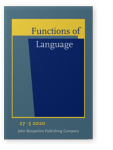Vol. 27:3 (2020) ► pp.247–279
Competing ditransitive constructions in Enets
This paper reports on a corpus study of two ditransitive constructions in Enets (Uralic, Samoyedic): the standard ditransitive construction and the so-called Destinative construction involving a specific destinative nominal morpheme. We suggest that the mutual distribution of the two competing constructions depends on referential properties of theme and information structure of the clause. The Destinative construction is used when a theme is indefinite, the standard ditransitive construction is used when a theme is definite. Most often, definiteness of a theme is also accompanied by specificity of a recipient; the combination of an indefinite theme and a non-specific recipient has not been attested at all. There is also a small number of cases when the standard ditransitive construction is used in clauses with an indefinite theme: in all such cases recipients are non-standard from the information structure point of view, they are either topical, emphatic, or extraposed. We suggest that both contexts of usage of the standard ditransitive construction can be explained if we describe its main discourse function as highlighting the known referents in discourse, be it definite themes or topical, emphatic, or extraposed recipients. The main discourse function of the destinative construction is then introducing new referents in the theme position.
Article outline
- 1.Introduction
- 1.1The phenomenon
- 1.2The data
- 1.3Structure of the paper
- 2.Formal properties of the two ditransitive constructions
- 2.1Standard ditransitive construction
- 2.1.1Case of theme
- 2.1.2Case of recipient
- 2.2Destinative construction
- 2.2.1Destinative affix and Destinative NP
- 2.2.2Place of the destinative affix in nominal morphology
- 2.2.3Syntactic functions of the Destinative construction
- 2.2.4Previous accounts of the Northern Samoyedic Destinative construction
- 2.1Standard ditransitive construction
- 3.Mutual distribution of the two ditransitive constructions: Referentiality of theme and recipient
- 3.1Contexts for the Destinative construction
- 3.2Impossible contexts for the Destinative
- 4.Mutual distribution of the two ditransitive constructions in case of an indefinite theme
- 4.1Indefinite themes: Extraposition of recipients / beneficiaries
- 4.2Indefinite themes: Recipient / beneficiary as topic with theme as focus
- 4.3The language decay factor
- 5.Conclusion
- Acknowledgements
- Notes
- Abbreviations
-
References
